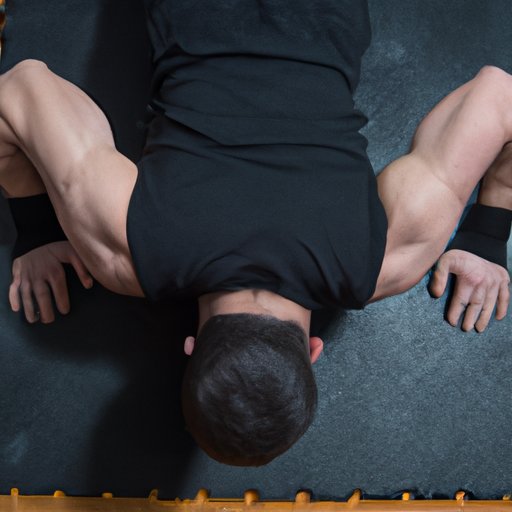
How much weight is in a push up?
Push-ups are one of the most popular exercises in the world, and for good reason. They’re simple, effective, and can be done almost anywhere without any equipment. But have you ever wondered how much weight you’re actually lifting when you do a push-up? In this article, we’ll explore the benefits of push-ups, explain how much weight you’re really pushing, and provide tips for beginners as well as more advanced fitness enthusiasts.
Exploring the Benefits of Push-Ups for Strength Training
Push-ups are an excellent exercise for building strength, especially in the chest, shoulders, and triceps. They’re also a great way to work your core and improve your overall stability. One of the best things about push-ups is that they’re a bodyweight exercise, meaning you can do them anywhere, anytime, without any equipment.
When it comes to push-ups, your body weight plays a significant role in how much weight you’re lifting. For example, a woman who weighs 120 pounds will lift less weight than a man who weighs 200 pounds, all other factors being equal. The more you weigh, the more weight you’re pushing during a push-up, which makes it a great exercise for people who want to build strength without having to lift heavy weights.
There are many different types of push-ups, each of which targets slightly different muscle groups. For example, a wide-grip push-up works your chest and shoulders more than a standard push-up, while a diamond push-up places more emphasis on your triceps.
Is Stronger Always Better? The Surprising Benefits of Lighter Push-Ups
It’s common to assume that heavier push-ups always lead to better results. However, this isn’t necessarily the case. In fact, doing lighter push-ups can sometimes be more beneficial than doing heavy ones.
One of the benefits of lighter push-ups is that they can help reduce your risk of injury. When you do a heavy push-up, you’re putting a lot of stress on your joints and muscles. If you’re not careful, this can lead to overuse injuries or other types of damage. By doing lighter push-ups, you can reduce the overall stress on your body and lower your risk of injury.
Another benefit of lighter push-ups is that you can typically do more reps than you can with heavy ones. This is because your body doesn’t have to work as hard to push itself back up. By doing more reps, you can help build endurance and improve your overall fitness level.
How Much Weight Are You Really Pushing with a Push-Up?
The amount of weight you’re pushing during a push-up can vary depending on several factors, including your body weight, form, and hand placement.
To calculate the weight being lifted, you need to know your body weight and the percentage of your weight that you’re lifting during the push-up. For example, if you weigh 150 pounds and you’re lifting 60% of your weight during a push-up, then you’re lifting 90 pounds (150 x 0.6 = 90).
Your form can also impact the amount of weight being lifted. If you have poor form, you may not be engaging all of the necessary muscles during the push-up, which can make it harder to lift your body weight.
Hand placement is another factor that can impact the amount of weight being lifted. When you do a push-up with your hands close together, you’re targeting your triceps more than your chest. When your hands are wider apart, you’re targeting your chest more than your triceps.
Female vs. Male Push-Up Strength: Is There Really That Much of a Difference?
It’s common to assume that men are stronger than women, but when it comes to push-up strength, the differences aren’t as significant as you might think.
Research has shown that women can typically do around 50% of the number of push-ups that men can do, but this is largely due to differences in upper body strength and muscle mass. However, with proper training and technique, women can become just as proficient at push-ups as men.
Regardless of gender, the most important thing is to find the right balance between pushing yourself and avoiding injury. By using proper technique and gradually increasing the weight you’re lifting, you can build strength and improve your overall fitness level, regardless of your gender.
Push-Ups for Beginners: How to Build Strength and Confidence Without Overexertion
Push-ups can be challenging, especially for beginners. If you’re just starting out, it’s important to remember that proper technique is more important than the amount of weight you’re lifting.
One modification that beginners can make is to do push-ups against a wall or bench instead of on the ground. This can help reduce the amount of weight you’re lifting and make the exercise easier to do. As you build strength, you can gradually move to more challenging variations of the push-up.
It’s also important to listen to your body and avoid overexertion. Push yourself to do more reps or lift more weight, but don’t push yourself so hard that you risk injury. Building strength takes time, so be patient and stay committed to your training.
Conclusion
In conclusion, push-ups are an excellent exercise for building strength and improving overall fitness. The amount of weight you’re lifting during a push-up can vary depending on several factors, including your body weight, form, and hand placement. Whether you’re a beginner or an advanced fitness enthusiast, there are many different variations of the push-up that you can use to challenge yourself and build strength over time.
If you’re interested in learning more about push-ups and strength training in general, there are many resources available online, including videos, tutorials, and training programs. By staying informed and staying committed to your training, you can achieve your fitness goals and become stronger and healthier than ever before.




